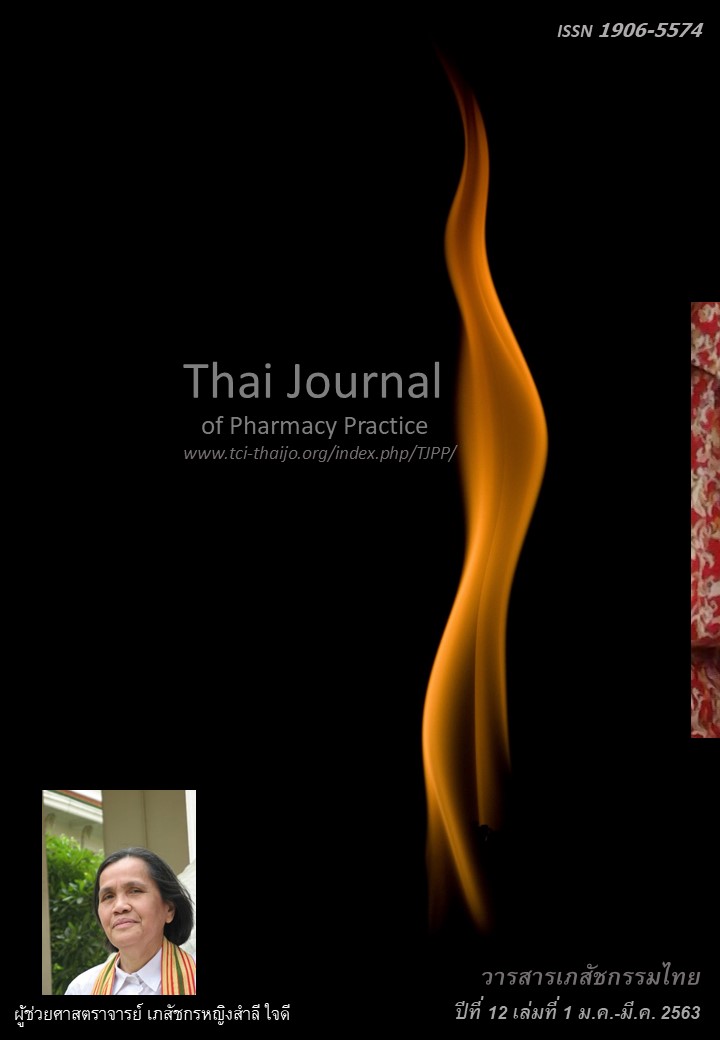สถานการณ์ยาคู่เหมือนในชุมชน: กรณีศึกษาตำบลแห่งหนึ่งในภาคตะวันออกเฉียงเหนือ
Main Article Content
บทคัดย่อ
วัตถุประสงค์: เพื่อศึกษาสถานการณ์ยาคู่เหมือนที่มีการกระจายอยู่ในชุมชน ในแง่ของลักษณะรูปแบบของยาที่แสดง จำนวนที่พบ กลุ่มยา ประเภทของยาตามกฎหมาย และความเสี่ยงที่อาจเกิดขึ้น วิธีการ: การศึกษาเป็นการวิจัยเชิงสำรวจในตัวอย่างจำนวน 330 หลังคาเรือนที่เลือกมาตามสัดส่วนจำนวนประชากรในแต่ละหมู่บ้านในตำบล การศึกษายังเก็บข้อมูลจากร้านยาประเภท ข.ย. 1 จำนวน 3 ร้าน ข.ย. 2 จำนวน 1 ร้าน และร้านค้าปลีกที่มีการจำหน่ายยา จำนวน 28 ร้าน การเก็บข้อมูลดำเนินการระหว่างเดือนพฤศจิกายน 2560 – กุมภาพันธ์ 2562 ผลการวิจัย: การศึกษาพบยาที่จัดเป็นยาคู่เหมือนในชุมชนจำนวนทั้งสิ้น 180 รายการ รวม 223 คู่ยา คู่ยาที่มีความเสี่ยงที่อาจเกิดขึ้นจากลักษณะรูปแบบที่แสดงจำนวน 118 คู่ยา คิดเป็นร้อยละ 52.91 ของคู่ยาที่พบทั้งหมด ลักษณะที่พบมากที่สุดคือ เป็นยาของบริษัทเดียวกันยาที่มีทั้งบรรจุภัณฑ์และชื่อที่คล้าย/เหมือนกัน มีตัวยาสำคัญเดียวกัน แต่มีหลายความแรง/รูปแบบ พบจำนวน 28 คู่ยา คิดเป็นร้อยละ 23.73 ในการสำรวจครั้งนี้ยังพบผลิตภัณฑ์สุขภาพที่มีลักษณะเป็นคู่เหมือนของยา จำนวน 1 คู่ สรุป: ยาคู่เหมือนในชุมชนนั้นเป็นปัญหาที่ไม่แตกต่างจากในโรงพยาบาล คู่ยาที่มีความเสี่ยงที่อาจเกิดขึ้นจากลักษณะรูปแบบที่แสดง เป็นปัญหาที่มักเกิดจากการออกแบบชื่อยา ฉลากและบรรจุภัณฑ์ รวมไปถึงลักษณะยาให้มีความเหมือนหรือคล้ายคลึงกัน ทั้งที่เกิดจากความตั้งใจหรือไม่ตั้งใจของบริษัทยาเอง
Article Details
ผลการวิจัยและความคิดเห็นที่ปรากฏในบทความถือเป็นความคิดเห็นและอยู่ในความรับผิดชอบของผู้นิพนธ์ มิใช่ความเห็นหรือความรับผิดชอบของกองบรรณาธิการ หรือคณะเภสัชศาสตร์ มหาวิทยาลัยสงขลานครินทร์ ทั้งนี้ไม่รวมความผิดพลาดอันเกิดจากการพิมพ์ บทความที่ได้รับการเผยแพร่โดยวารสารเภสัชกรรมไทยถือเป็นสิทธิ์ของวารสารฯ
เอกสารอ้างอิง
2. Thongyang P. Rural pharmacy club and drug management in the community. Thaidrugwatch 2013; 5: 3-5.
3. Prasertsuk S. Drug use in social and cultural dimension of urban community [dissertation]. Khon Kaen: Khon Kaen University; 2011.
4. Kiatying-Angsulee N. Safety for all from unlawful medicines [editorial]. Thaidrugwatch 2013; 5: 2.
5. Kiatying-Angsulee N. Review of Thai drug registra- tion. Thaidrugwatch 2014; 6: 3-15.
6. Tomacha N. Community drug problems and solutions : Information on 13 provinces confirms the risk of inappropriate drugs in the community. Thaidrug watch 2013; 5: 10-2.
7. Aongsomwang S, editors. Smart buyer magazine. Nonthaburi: Foundation for Consumers; 2016. p. 31-39
8. Academic Centers for Drug System Surveillance and Development. Management of problems on registra- tion of inappropriate antibacterial formulations [on line]. 2016. [cited Jan 5,2017]. Available from: www .thaidrugwatch.org/blog/wp-content/uploads/2016/10 /Letter25590623_Attach ment2_List.pdf.
9. Wongboonnak P. Look-alike sound-alike drugs situ ation in thailand. HCU Journal 2018; 22: 205-16.
10. Chumchit C. Development of medication safety management system for look-alike sound-alike drugs in public hospital [dissertation]. Nakorn Pratom: Silpakorn University; 2013.
11. Booddawong B, Kiatying-Angsulee N, Wanleepong K, Boonmanus L, Kadsomboon O, Dokbua J, et al. Sources and distribution of unlawful medicines in 8 provinces of Thailand : to Inform the public policy change. Isan Journal of Pharmaceutical Sciences 2016; 11 (Supplement): 260-8.
12. Yodsapongsit K. Household remedy usage in Kranuan district : Khon Kaen province [dissertation]. Khon Kaen: Khon Kaen University; 2008.
13. Wongboonnak P. Resolving the problems on look-alike sound-alike drugs at the system level. Thai Journal of Pharmacy Practice 2017; 9: 251-8.
14. Drug Act, Amendment (No.3), B.E.2522. Royal Gazette No. 96, Part 79 special (May 13, 1979).
15. Wibulponpasert S, Chokwiwat W, Tantivess S,editors. Thai drug system. Nonthaburi: Internatio- nal Health Policy Program; 2005. p. 5-32.
16. Drug Act, B.E. 2510. Royal Gazette No. 84, Part 101 special (Oct 20,1967).
17. Drug Act, Amendment (No.5), B.E.2530. Royal Gazette No. 104, Part 278 special (Dec 31, 1987).
18. Healthcare Accreditation Institute. Patient safety goals: SIMPLE Thailand 2018. Faymataensakset foon; 2018. p. 61-80.
19. National Health Security Office, Health Consumer Protection Program, Primary Care Pharmacist Club. Guide for pharmacists in pharmaceutical operations in primary care units. Bangkok: Srimuang printing; 2018.
20. Yothapakdee K, Snae Namahoot C. System for checking the similarity of drug names in National List of Essential Medicine using name matching algorithms techniques. In: National Conference on Information Technology: NCIT 5th: Unico Grand Sandara Hotel, Cha-Am; 2013. p. 281-6.
21. Chinpanthana N. Semantic images interpretation using a similarity measure with graph matching. Bangkok: Dhurakij Pundit University; 2014.
22. Chantasitiporn J. Medicine tablet identification using feature extraction based on neural network [dissertation]. Nakorn Pratom: Silpakorn University; 2005.


